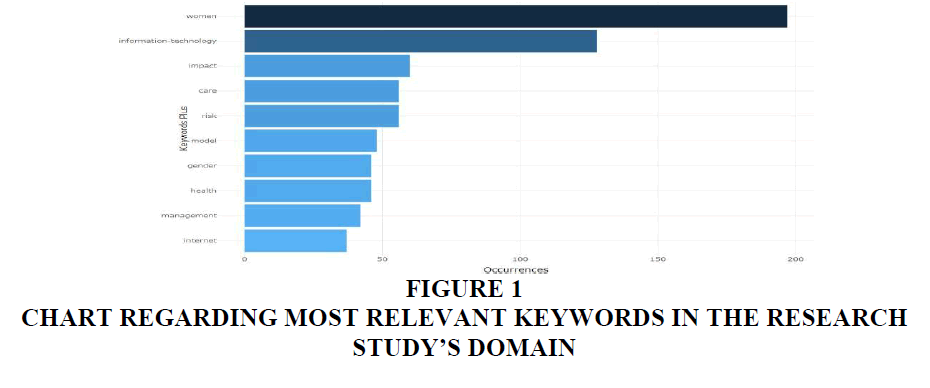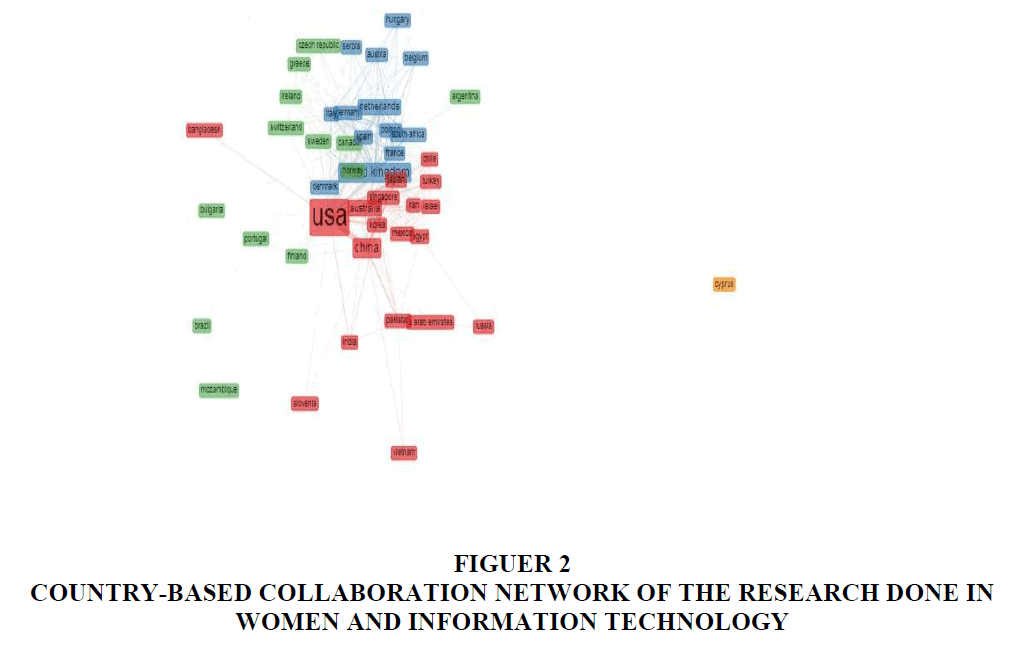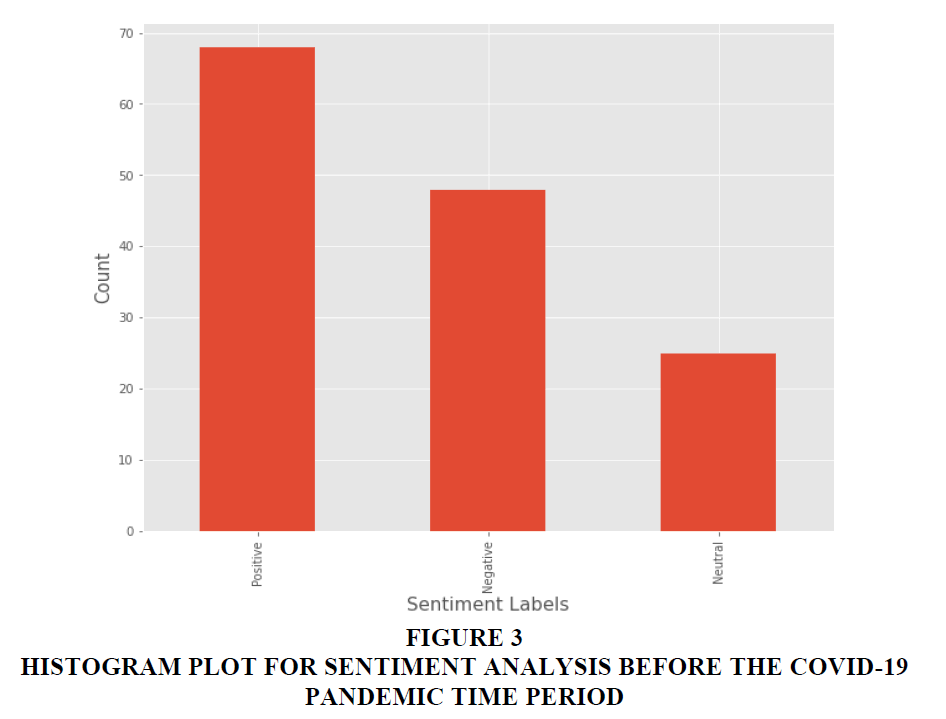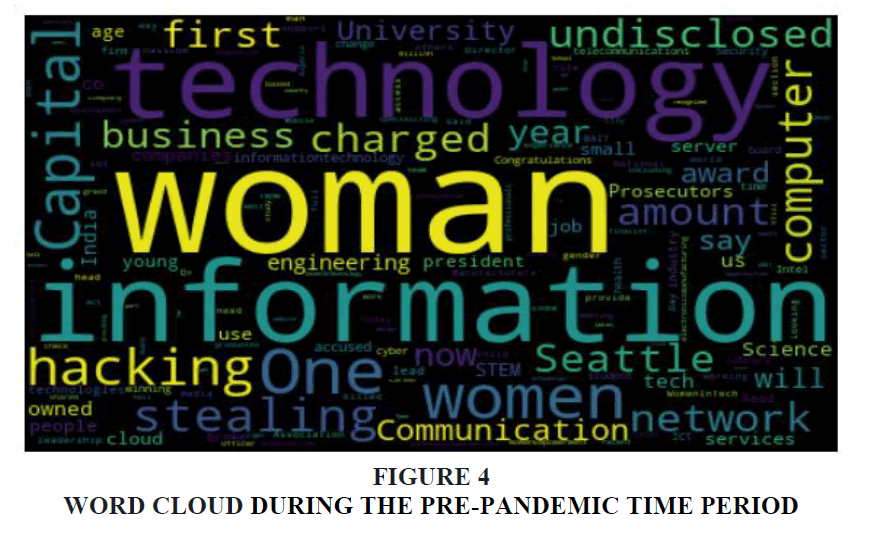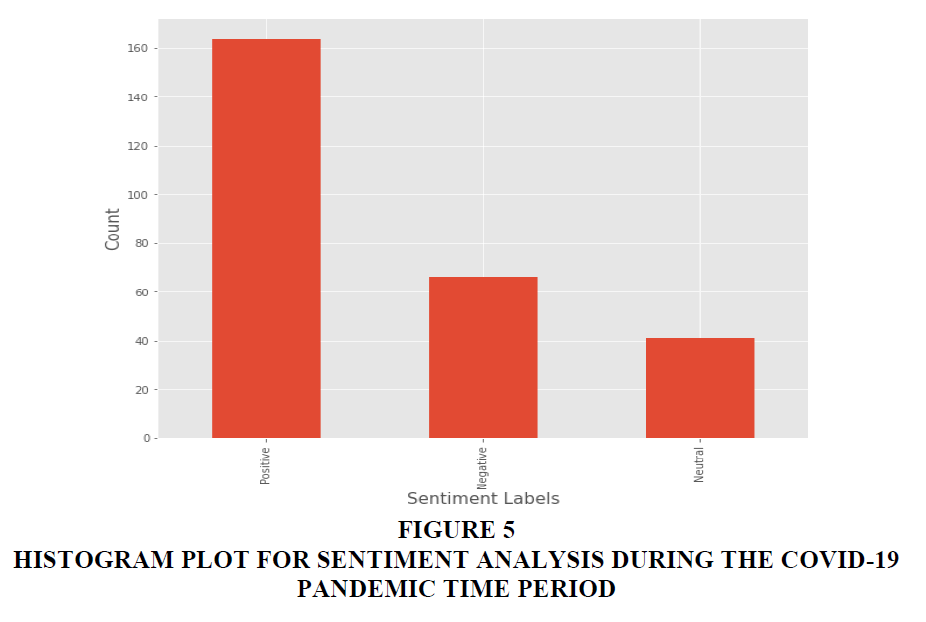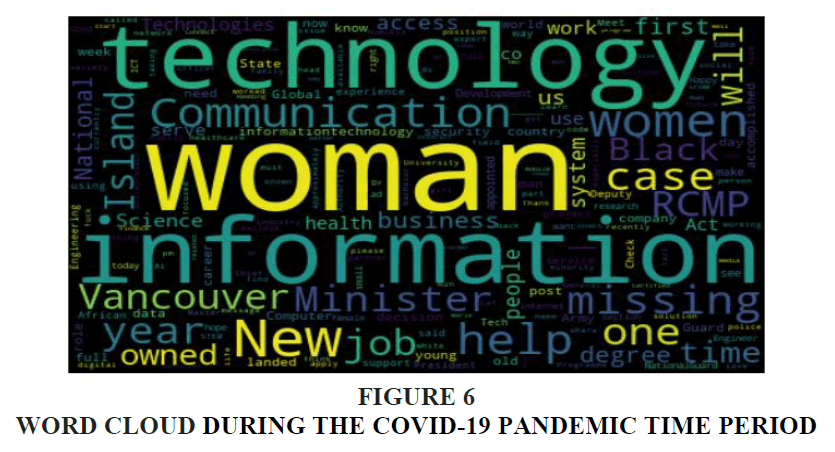Review Article: 2024 Vol: 28 Issue: 6S
Women and Information Technology: A COVID-19 Pandemic Perspective
Sarthak Sengupta, IIHMR University, Jaipur
Nimisha Singh, Indian Institute of Information Technology – Allahabad, Prayagraj
Anurika Vaish, Indian Institute of Information Technology – Allahabad, Prayagraj
Citation Information: Sengupta, S., Singh, N., & Vaish, A. (2024). Women and information technology: a covid-19 pandemic perspective. Academy of Marketing Studies Journal, 28(S6), 1-13.
Abstract
A massive surge has been witnessed among the women working in the field of Information Technology. The research study attempts to understand the scenario of women working in the IT/ITes sector before and during the coronavirus period. Secondary data was analyzed to understand the same. The data extracted from the review of the literature helped in finding the research gaps and problems to formulate the research objectives along with the relevant hypothesis. The qualitative and quantitative analysis was done to get a bird’s-eye view of the research studies done in the area of women and information technology. Tweets from a microblogging social networking platform named Twitter were collected before and during the COVID-19 pandemic. It was found that the sentiments of Twitter users were mostly positive and plenty of research studies have been done in the past. But this study laid the foundation stone for understanding the scenario of women in information technology during the COVID-19 pandemic.
Keywords
COVID-19 Pandemic, Coronavirus Crisis, Women, Information Technology, Twitter.
Introduction
The COVID-19 pandemic has given rise to the “work from home” concept which proved to be fruitful in some IT companies. The Information Technology (IT) industry started to grow deep inroads in India when globalization started here in the post-1990s. Engineering and related fields have always been a far mile for women in India because of the traditional practices that developed in ancient times. In the context of women in other countries, the same kind of trend is observed. Even after education was available in almost all countries, it is observed that, in STEM fields (Science, Technology, Engineering, and Mathematics), women constitute only 20% of the graduates of these fields. Out of which, only 7% further proceed to the real-world market for jobs. A look at all the tech companies in India, it is found that for every female engineer, there are three male engineers. But the COVID-19 pandemic has sparked an inspiration among people vulnerable to technology and healthcare. Therefore, it is advised to embrace digital inclusion gradually for ensuring universal access to technology Connley (2022).
The COVID-19 pandemic has pushed the rapid deployment of Information Technology to achieve the new normal. The work-from-home pedagogy has been on a massive rise in computer-related sectors. In recent years, there has been a significant rise in the number of women getting employment in the IT/ITes (Information Technology or Information Technology Enabled Services) sector. The statistics can be also observed in higher positions, like the CEOs of IT companies. According to Fortune 500 companies’ statistics, there were only 14 CEOs of these companies in 2020, whereas the count has increased to 23 women in 2021. Even better results in teamwork and management fields also led to an increase in the recruitment of female employees Perez-Escolar & Canet, (2023).
According to the report of NCWIT (National Center for Women & Technology), only 25 percent of all computing occupations are held by women . Women also tend to quit their job sooner than males because of several reasons related to their workplace and environment. Evidence from various reviews of the literature collected it is suggested that in workplace conditions it has been observed that a lack of access to key creative roles along with a sense of feeling of being stalled in one’s career can be some of the most significant factors contributing to female attrition in the IT/ITes industries. This paper focuses on analyzing these problems and providing efficient solutions to them Roy et al. (2021).
Technology-oriented fields were dominated by males around the world male-dominated. But in a dynamic and fast-growing country where opportunities for female participation in the IT sector are increasing, it has been witnessed that traditional barriers persist. But in the recent decade, the statistics show an increase in the number of women. This research is an attempt to address this increase in the number of women in the Information Technology sector. This research also attempts to analyze the problems faced by women in this field that prevented the early growth of women along with men in this field. Further discussion on the problems that are faced by women in the IT sector was also done. Many women faced health issues due to the Coronavirus crisis. In this study, some possible solutions have been discussed that foster the growth in the number of women in this field. Moreover, all the details regarding the increase in female representation would be discussed. The study discussed the review of literature in the next section and also pondered upon the research studies done in the area Ashcraft et al. (2010).
Review of Literature
Menson, (2012) The review of the literature was done to observe the scenario and research studies done on women and information technology. “No industry or country can reach its full potential until women reach their full potential. This is especially true of science and technology, where women with a surplus of talent still face a deficit of opportunity” as quoted by Sheryl Sandberg, the Chief Operating Officer of Facebook. The potential cannot be reached due to many social and structural factors. These factors can be abolished or removed only if the underrepresentation of women in this field decreases. Research on the underrepresentation of women in science and engineering-related field is scarce. Since many benefits have been observed in areas of innovation, administration, management, and development where women are involved, research has to be made on factors that improve female representation in scientific sectors. The factors might involve every part of a girl's journey, right from parents' involvement to marital issues. A study based on Sub-Saharan African economies also suggested that efficient governance can be done with the help of Information and Communication Technology (ICT) for overall growth and development.
Universum (2019) No less than 200 million results get populated when someone searches in Google regarding ‘Increasing number of women in the IT Sector (as of Oct 2019), with articles, organizations and governments debating and highlighting the issue. And yet, despite this, there are still three times as many men in the IT sector as there are women. To understand why such a widely represented and understood issue persists and needs to be acknowledged, the study discusses a simple definition of unconscious bias and conscious bias.
Bian, et al. (2017) Unconscious bias can be defined as the act of judging people based on our unconscious thoughts, beliefs, or feelings. It is when the person’s background, societal stereotypes, personal experiences, and culture impact the decision-making and actions without realization. Conscious Bias is mainly focused on responsiveness and awareness. This however is something we do inadvertently. However, there are many beliefs that people follow in full awareness. Unconscious biases are generally deep-seated stereotypes that have been formed in our brains through years of different influences we were exposed to, right from our childhoods. This can be illustrated by a study where children were asked to guess whether a smart protagonist in a story was a man or a woman. It was observed that by the age of 5 to 6, girls were less likely to assume that the protagonist was a woman than boys were to guess that he was a man. The study also found that by the age of 6, girls begin to avoid activities said to be for smart children. These findings also suggested that gendered notions of intellectual capability are acquired early and have an immediate effect on children’s interests.
This is something that echoes into adulthood and right into the modern technological workplace. The first phrases that come to mind in the context of ‘women in tech’ are the glass ceiling, the maternal wall, the gender pay gap, and most importantly women just not being smart enough. Why each of these issues weighs into our study of increasing the number of women in the IT sector is self-evident. These are simple indicators of hostility, fewer opportunities for growth, less medical support, disinterestedness, and cloistering, all of which gift an aspiring smart woman a lack of motivation and faith to join the industry and an early departure (if she even had a chance to join it, to begin with); and to the HR system, a plethora of hiring and growth malpractices.
Paul et al. (2015) One of the most challenging parts of women’s participation in this field is work-life balance. The study has been carried out to see how workplace spirituality makes a difference in maintaining a work-life balance in women’s demanding life. It has been studied that women tend to leave IT jobs more frequently compared to men which result in more hiring of men compared to women Mension (2012).
CRY, 2018 In a patriarchal country like India, conscious biases are very much rampant despite radical education and work reforms post-1947. Most girls are still not privileged enough to reach the level of higher studies due to social (including Early marriage (66%), household chores (65%), and economic factors - Cost of education (62%)). Even if they go for higher studies, they still prefer jobs that are less demanding like teaching or other time-bound jobs. Additionally, they also need a strong support system at home so that they can balance work and home duties. This leads to society consciously accepting that women are not on par. And unless society as a whole does not give up on this unforgiving notion, we cannot see an equal number of women in technology.
Crittenden, et al. (2019) With the help of the Technology Acceptance Model and Information communications technology (ICT) research has been done to see the self-efficacy, self-reliance, and empowerment of women micro-entrepreneurs. These models help in bridging the social capital gap, competence, and perceived control having an immense influence on women’s goal internalization. Empowering women micro-entrepreneurs in emerging economies: The role of information communications technology). The introduction of Information technology in women’s lives not only improved their self-efficacy but also helped in social capital bridging. It enhanced women’s goal identification, impact, control over overwork, and proficiency.
Chatterjee, et al. (2020) Information and communication technology (ICTs) empowered especially marginalized women. It has contributed a lot to women’s entrepreneurship. Gender equality is a worldwide issue that needs to be addressed. ICT helps in gender equality and also helps in innovation. Crittenden, et al. (2020) Technology has the capability to transform social capital and reduce the gap in socioeconomic status. The application of technology helps in marketing, product ordering, and training sessions.
Lovell & Harris (2021) A descriptive analysis stated that most of the women use the application to avail potential benefits. The use of apps helps in improving the outcomes of efforts by these women.
Adams & Kerri Morgan, (2021) Women are underrepresented in the IT field. They can solve complex IT problems and help others too. Most women do not have transparency about the requirements of the job profile needed in the IT field which results in their lower participation. We need to understand this perspective of women and guide them better.
Mivehchi, (2019) The study has been done to see the impact of technology on women’s entrepreneurship in Iran. Results show that IT has an impact on increasing productivity and sales.
Ranajee, et al. (2021) A relevant study on systematic review and bibliometric analysis motivated the authors to go ahead with this research work.
Yum, (2022) Moreover, Twitter had been an essential source durnng the Coronavirus crisis The literature review proved to be a rich source of information to go ahead with the research study.
Methodology
The study focuses on secondary data-based research. The literature review was collected and analyzed to ensure the proper formulation of research objectives based on the gaps and problems. Sentiment analysis was done on the tweets extracted from social media named Twitter primarily used for micro-blogging all over the world. The process is done with the help of machine learning and natural language processing algorithms. The research study was done with the help of software and tools namely - Microsoft Excel, Google Colaboratory (COLAB), Python, and RStudio.
The main objective of the study is to understand the aspects of women working in jobs related to information technology before and during the Coronavirus period. Finding the sentiments of the concerned people on the domain was the need of the hour. So, the study also demonstrated the research work done in the area along with the sentiments of Twitter users in this domain. This also helped in suggesting effective remedies and efficient strategies to cope with such problems during such trying times of the Coronavirus crisis.
The research study has developed a hypothesis based on secondary data-based sentiment analysis. The team of research experts along pondered upon finding novel ways to analyze the hypothesis. A total number of 3 hypotheses were formulated which are given as follows: -
Null Hypothesis HO - The tweets had an equal proportion of positive sentiments before and during the pandemic.
Alternate Hypothesis HA - The tweets had an unequal proportion of positive sentiments before and during the pandemic.
Null Hypothesis HO - The tweets had an equal proportion of negative sentiments before and during the pandemic.
Alternate Hypothesis HA - The tweets had an unequal proportion of negative sentiments before and during the pandemic.
Null Hypothesis HO - The tweets had an equal proportion of neutral sentiments before and during the pandemic.
Alternate Hypothesis HA - The tweets had an unequal proportion of neutral sentiments before and during the pandemic.
Hence, the research objectives, gaps, problems, and hypotheses were formulated accordingly. The next section discussed the analysis and findings of the research study. It also provided a panoramic view of the women in information technology (IT/ITes sectors) with the help of sentiment analysis on Twitter data before and during the Coronavirus period Pérez-Escolar & Canet, (2022).
Analysis and Findings
The literature review was collected in the form of a table with the help of Microsoft Excel. Then the data were analyzed with the help of a machine learning tool - RStudio. The package named Bibliometrix Aria & Cuccurullo, (2017) helped in understanding the mapping analysis of the research done in the area of women and information technology. All research articles were extracted from the renowned research database Web of Science Core Collection (Clarivate). The file extracted was analyzed to ensure proper bibliometric-based quantitative and qualitative analysis.
The most relevant keywords in the research area were observed to propose the set of parameters for moving ahead. The keywords provided food for thought to conduct more analysis. Figure 1 shows the most relevant keywords in the research study’s domain. The most relevant keywords were found to be - women, information technology, impact, care, and risk.
The collaboration network is an important parameter to understand the scenario of research studies done on women and information technology. The field chosen was countries, the normalization type was selected as association along with an automatic network layout, and the Louvain clustering algorithm was implemented. Isolated nodes were not removed. Figure 2 shows the country-based collaboration network of the research done in the relevant domain. It can be observed that the USA and China are major countries pursuing research in this area along with other countries.
Figure 2 Country-Based Collaboration Network of the Research Done in Women and Information Technology
The research study also attempted to analyze the sentiments of Twitter users regarding women and information technology with the help of Python and Google Colaboratory (COLAB). Nowadays, Twitter is an important source of information for most of the research studies Reveilhac, et al. (2022). Tweets were extracted from the renowned micro-blogging social networking platform Twitter and sentiment analysis was conducted. The process was done with the help of Twitter API for collecting related tweets. Python libraries helped to clean, pre-process and analyze the sentiments of tweets. Tweets were collected between two-time intervals. The first-time range is the pre-pandemic period and the second part is the time period during the COVID-19 pandemic. The sampling frame is Twitter users around the world. The details of the sentiment analysis and its findings are as follows Figures 2-4.
Analysis during the pre-pandemic time period from 1 January 2019 to 28 November 2019 - A total of 7659 tweets were extracted during the period. But after cleaning the dataset and removing the re-tweets (duplicate tweets) a total of 141 tweets were collected for sentiment analysis. Word cloud was also done to check the frequency of keywords’ usage on various tweets. It is being generated on the basis of the occurrences of various keywords. Table 1 shows the metadata regarding sentiment analysis during the pre-pandemic time period provides the histogram plot for Sentiment analysis during the pre-pandemic time period provides the word cloud during the pre-pandemic time period Rights, (2019).
| Table 1 Sentiment Analysis before the Covid-19 Pandemic Time Period | |
| Type of Sentiment | No. of Tweets |
| Positive | 68 |
| Negative | 48 |
| Neutral | 25 |
| Total | 141 |
b> Analysis during the COVID-19 pandemic time period from 29 November 2019 to 26 August 2021 - A total of 14697 tweets were extracted during the period. But after cleaning the dataset and removing the re-tweets (duplicate tweets) a total of 271 tweets were collected for sentiment analysis. Word cloud was also done to check the frequency of keywords’ usage on various tweets. Table 2 shows the metadata regarding sentiment analysis during the pre-pandemic time period. Figure 5 provides the histogram plot for Sentiment analysis during the pre-pandemic time period. Figure 6 provides the word cloud during the pre-pandemic time period.
| Table 2 Sentiment Analysis During The Covid-19 Pandemic Time Period | |
| Type of Sentiment | No. of Tweets |
| Positive | 164 |
| Negative | 66 |
| Neutral | 41 |
| Total | 271 |
The data was cleaned and found to be reliable. The results were successfully obtained from natural language processing-based sentiment analysis of the tweets collected from Twitter. It was found that the percentage of negative, and neutral tweets during the COVID-19 pandemic were lesser than in the pre-pandemic timeline. Whereas it was observed that the percentage of positive tweets during the pre-pandemic timeline was lesser than during the COVID-19 pandemic period. The proportion of the tweets was also computed accordingly. Table 3 provides information regarding the ratio between the sentiment analysis-based reliable tweets and the total number of authentic tweets extracted from Twitter. The equations used to compute the data analysis are as follows -
| Table 3 Proportionality Ratio of Sentiment Analysis-Based Tweets Before and During the Covid-19 Pandemic | ||
| Type of Sentiment | Analysis of tweets before the COVID-19 pandemic | Analysis of tweets during the COVID-19 pandemic |
| Positive | 68/141 = 0.48 or 48% | 164/271 = 0.61 or 61% |
| Negative | 48/141 = 0.34 or 34% | 66/271 = 0.24 or 24% |
| Neutral | 25/141 = 0.18 or 18% | 41/271 = 0.15 or 15% |
1. Proportionality ratio of tweets with positive sentiments = Number of tweets with positive sentiments / Total number of tweets.
2. Proportionality ratio of tweets with negative sentiments = Number of tweets with negative sentiments / Total number of tweets.
3. Proportionality ratio of tweets with neutral sentiments = Number of tweets with neutral sentiments / Total number of tweets.
The rigorous analysis performed in the study also helped in providing the results of the hypothesis which are as follows.
1. In the first case, the null hypothesis was rejected and the alternate hypothesis was accepted. It was found that the proportion of tweets was unequal on the basis of positive sentiments analyzed before and during the COVID-19 pandemic.
2. In the second case, again the null hypothesis was rejected and the alternate hypothesis was accepted. It was found that the proportion of tweets was unequal in number based on negative sentiments analyzed before and during the pandemic.
3. Similarly in the third case, the null hypothesis was rejected and the alternate hypothesis was accepted. It was found that the proportion of tweets was unequal based on neutral sentiments analyzed before and during the pandemic.
So, it was found that all three alternate hypotheses were accepted. All the sentiments were unequal, i.e., negative, positive, and neutral sentiments. The analysis and findings also throw light on how the sentiments of the tweets changed due to the Coronavirus crisis. The positivity in sentiments was witnessed during the COVID-19 pandemic whereas the negative sentiments decreased during the pandemic in comparison to the pre-pandemic time. Rapid implementation of IT infrastructure and the work-from-home mode was found to be the new normal among workers during the COVID-19 pandemic.
Recommendations and Future Scope
The study was conducted during the COVID-19 pandemic. An essential future scope of research is to conduct the study to analyze the scenario after the coronavirus crisis. More data can be collected from various sources to get deeper insights regarding women and information technology. Moreover, further research studies could employ a mixed-methods approach to explore new methodologies and initiatives to help maintain gender diversity in the IT Sector.
Some of the proposed solutions to resolve such issues are-
• Removing Leaky Pipelines - Literature in educational institutions shows that women tend to drop out of school and colleges at young ages due to the ‘Leaky Pipeline’ which shows that system itself sometimes has problems due to which retarded women feel skeptical to progress in science fields. An example of such a leaky pipeline can be the stereotypical thinking of people of girls not doing well in STEM subjects. Removing such beliefs through campaigns, awareness programs and structural changes in the conventional methods would improve the growth of women in STEM fields.
• Improving Selection Criteria Scheme - We observe that the representation of women in top engineering colleges is drastically low when compared to male representation. In India, selection criteria for top engineering colleges (via JEE), put a high discrete cut-off test score for eligibility in those colleges. This leaves capable female engineers systematically disadvantaged in the admissions process. Putting reservations for the seats and decreasing the cut-off for female candidates would help for more female representation in these colleges. One such initiative was taken by the Joint Seat Allocation Authority, India (JOSAA) where they introduced female-only seats in various colleges across the country. For example, IITs, IIITs, NITs, and other CFTIs are governed by the central government.
1. Providing Financial aid and scholarships - We see that providing financial aid for certification courses could be helpful to promote the growth of women in tech. Also, scholarships could be provided at the college/university level to encourage more women into STEM fields.
2. Preparing Women for Industry-Oriented Aspects - Colleges provide a perfect platform to enrich one’s skills in any manner. Participation in technical clubs in colleges would help women to improve the skills they require for industrial exposure. Additionally, women could be prepared for the interviews during placements. Lack of interview preparation is one of the biggest turnoffs, according to Hackerrank women in Tech Report 2019. So, it involved the events of these kinds of exposure tech groups or clubs that would benefit women to be well prepared for the industry. However, women-specific tech groups can arise to encourage many other women to get interested in STEM subjects.
3. Recognizing Women as Digital Natives - Gen Z women, who are born in the age of the internet and technology, tend to code at an early age. Recognizing them as an equal competitor, and understanding that this generation of women is related much more to technology in their lifestyle than the previous generation. This approach will increase technological opportunities for women.
3. Creating Agencies for Promotions - To promote gender equality, agencies must be created to promote, monitor, and improve the facilities and treatment of women in the workplace to avoid cases of sexism, discrimination, and gender bias. Workplace Gender Equality Agency (WGEA) is an Australian Government created agency that promotes gender equality in the workplace.
4. Strengthening Networking and Mentoring Opportunities - To improve networking among women, conferences, tech talks, and hackathons could be held. In this manner, more women could be engaged in public events thus enabling them to interact technically and improving the technical outreach of women.
Quoting these findings is not to de-emphasize the need of the hour, but rather to restructure it. There is a need to build a sustainable technological ecosystem that can be leveraged to increase the influx of worthy, under-represented, less privileged women candidates and not be exploited by those otherwise or looked down upon by nay-sayers. Questioning a single woman’s work not only undermines the work and genuine efforts made by hardworking, highly qualified women in the industry, but it also trivializes years of systematic oppression and crime against women, and any if at all attempts made to uplift them. Collaboration and diversity must be embedded in our culture and the basic student level which nips the bud of biasing at its offset. Micro training programs, workshops, and events that focus on career paths can be one such medium to achieve this. Further building upon schemes like Beti Bachao, Beti Padhao, development, and visibility opportunities in the IT Sector (and STEM) would be beneficial if introduced. At the workplace, we need to collect, analyze and report information relating to retention and formally train HR and Managers in best practices and hold them accountable for retention. And finally, keep in mind the socio-cultural climate in India, and enact leave policies and services that support work-life integration, to help women trying to step into the field.
Conclusion
Even though the numbers are increasing, still few statistics need to be focused on. In conclusion, based on various studies, it is evident that the increase in the number of women in the IT/ITes sector is happening, with many initiatives being undertaken nationally and globally to improve gender statistics. Gender inequality in IT or even any other sector can only be fully eradicated when there is organized change in all walks of life – schools, colleges, society, households, offices, media, and so on. When we focus on sharing the great realities of technology with girls and also with their parents providing mentorship and role models, as well as hands-on experience— We can be confident that we will see women hit a true growth stage of impact and influence within this sector. And if we start now, we won’t have to wait longer to enjoy the success women can bring to this industry. During this research process, we have seen how technology education might impact women in the IT field. To achieve this in the future, innovative ways of thinking and methods are needed by enhancing technology-related skills and knowledge for better working life. Our findings reveal that social, biological and family support are the major factors that influenced women to choose the right career. This is important for women.
Nowadays plenty of research studies are focussing on women to address various gaps In recent years, luckily, global initiatives are making their move. One such initiative is Women Techmakers. It is Google's program for women to provide visibility, community, and resources for women in technology. Girls Who Code is a US non-profit organization that runs summer programs teaching programming skills to high school girls. IWish and WISE are also a few such initiatives that work to encourage women to lean towards STEM subjects and jobs (in Ireland and the UK). We observe that several such initiatives taken by various non-profit organizations and tech giants would encourage women in choosing the IT sector as a career path. Women are also improving their profiles on social networking platforms. Women empowerment and equity also needs to be supported. As an end note, we conclude that more women in IT/ITes sectors are not only advantageous to organizations in terms of revenue and diversity but also to women in terms of their confidence, personal growth, and identity in society. The statistics may not show an accurate and abrupt increase in the numbers, but it can be concluded that it is not just the pace of the increasing numbers of women in information technology that are important but the numbers themselves.
References
Adams, M., & Kerri Morgan, K. (2021) Relational sensibilities and women's participation in computer science and information technology degrees: A cultural-historical approach. Learning, Culture and Social Interaction, 28, 100464.
Indexed at, Google Scholar, Cross Ref
Aria, M., & Cuccurullo, C. (2017) Bibliometrix: An R-tool for comprehensive science mapping analysis. Journal of Informetrics, 11(4). 959-975.
Indexed at, Google Scholar, Cross Ref
Ashcraft, C., & Blithe, S. (2010). “Women in tech: The facts,”National Center for Women & Technology” (ncwit). Boulder CO.
Bian, L., Leslie, S., Cimpian, A. (2017) Gender stereotypes about intellectual ability emerge early and influence children’s interests,” Science, 355, 389–391.
Indexed at, Google Scholar, Cross Ref
Chatterjee, S., Gupta, S., Upadhyay,P. (2020): Technology adoption and entrepreneurial orientation for rural women: Evidence from India, Technological Forecasting and Social Change, 160, 120236.
Rights, C. (2019). You (CRY), 2019,“. Girl child Education: Role of Incentivisation and other enablers and disablers.
Connley, C. . A record number of women are now running Global 500 businesses. CNBC. (2021)Google Scholar
Crittenden, V.L., Crittenden, W. F., & Ajjan, H. (2019). Empowering women micro-entrepreneurs in emerging economies: The role of information communications technology . Journal of Business Research, 98, 191-203.
Indexed at, Google Scholar, Cross Ref
Crittenden, V., Crittenden, W., Ajjan, H. (2020): Women in sales in developing countries: The value of technology for social impact, Business Horizons, 63(5), 619-626.
Lovell, H., Harris, J.M. (2021). A survey exploring women's use of mobile apps in labour in the United Kingdom. Midwifery, 100, 103041.
Indexed at, Google Scholar, Cross Ref
Menson, A.E. (2012). Infrastructure, Export-Led Growth and Economic Development in Sub-Saharan Africa: An Empirical Analysis. IUP Journal of Managerial Economics. (2012).
Mivehchi, L. (2019). The Role of Information Technology in Women Entrepreneurship (The Case of E-Retailing in Iran), Procedia Computer Science, 158, 508-512.
Indexed at , Google Scholar, Cross Ref
Paul, M., Dutta, A., & Saha, P. (2015). Workplace spirituality and work-life balance: A Study among women executives of IT Sector Companies . International Journal of Management and Behavioural Sciences, 6(7), 267-277.
Pérez-Escolar, M., & Canet, F. (2023). Research on vulnerable people and digital inclusion: toward a consolidated taxonomical framework . Universal access in the information society, 22(3), 1059-1072.
Indexed at, Google Scholar, Cross Ref
Roy, S., Chowdhury, S. R., & Dixit, P. (2021). Corporate Governance in Banking: A Systematic Literature Review . IUP Journal of Corporate Governance, 20(2), 21-48.
Reveilhac, M., Steinmetz, S., & Morselli, D. (2022). A systematic literature review of how and whether social media data can complement traditional survey data to study public opinion. Multimedia tools and applications, 81(7), 10107-10142.
Indexed at, Google Scholar, Cross Ref
Universum (2019). Universum India Talent Survey .
Yum, S. (2022) Information networks for COVID-19 according to race/ethnicity. Inf Technol Manag (2022).
Indexed at, Google Scholar, Cross Ref
Received: 01-May-2024, Manuscript No. AMSJ-24-14782; Editor assigned: 02-May-2024, PreQC No. AMSJ-24-14782(PQ); Reviewed: 29-May-2024, QC No. AMSJ-24-14782; Revised: 26-Jul-2024, Manuscript No. AMSJ-24-14782(R); Published: 30-Aug-2024
